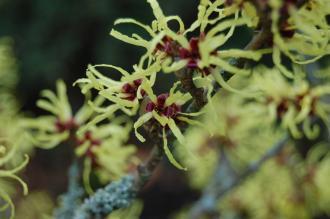
Hamamelis x intermedia 'Pallida' flower (21/01/2012, Kew London)
Position: Full sun to dappled shade
Flowering Period: Winter
Soil: Moist, well-drained
Eventual Height: 4m
Eventual Spread: 4m
Hardiness: 5b – 9a
Family: Hamamelidaceae
Hamamelis x intermedia ‘Pallida’ is a deciduous spreading small tree or large shrub. The light green alternate leaves emerge from short-stalked buds. The leaves are elliptic to nearly circular in shape, irregularly toothed along their edges and become a coppery orange in autumn. The branches of this tree form a ‘V’ shape. The fragrant flowers are bourne in clusters of two to four. The large individual sulfur yellow petals are fragrant, strap like, slightly wavy and 25mm long, with the centres of the flowers being red/ purple. The fruits are small, hairy, brown, oval capsules. It is grafted onto the rootstock of one of the other species of Hamamelis.
The species Hamamelis x intermedia is commonly known as the Hybrid Witchhazel. It is a hybrid between Hamamelis mollis and Hamamelis japonica. This plant was introduced into the UK around 1932. Subjective research has been carried out on the relative fragrance and leaf retention of various Hamamelis species and varieties by the curators of Scott Arboretum, unfortunately Hamamelis x intermedia ‘Pallida’ is not included on this list.
The etymological root of the binomial name Hamamelis is derived from the Greek amamelis ‘a tree with pear like fruits’. Intermedia is derived from the Latin inter ‘between’ and medius ‘middle’ in reference to this hybrid being between its two parents in terms of characteristics. Pallida is from the Latin meaning ‘pale/ yellow green’, referring to this varieties pale flowers.

Hamamelis x intermedia 'Pallida' (21/01/2012, Kew London)
The landscape architect may find Hamamelis x intermedia ‘Pallida’ is useful in dappled shade locations as a small tree with fragrant winter flowers and fantastic autumn leaf color.
Ecologically, H. x intermedia ‘Pallida’ attracts members of the Lepidoptera which includes butterflies and moths.
H. x intermedia ‘Pallida’ prefers moist, fertile, well-drained soils. It tolerates most pH of soil, although it prefers neutral to acidic soils.
The Royal Horticultural Society has given H. x intermedia ‘Pallida’ their prestigious Award of Garden Merit in 1993.
H. x intermedia ‘Pallida’ requires little maintenance.
Advertisement
